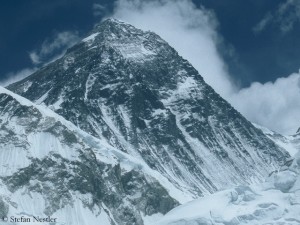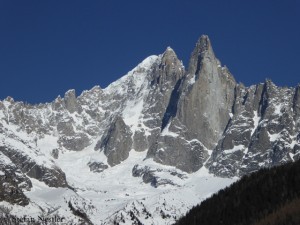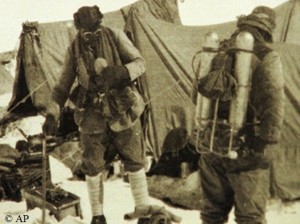40 years ago: Everest Southwest Face first climbed
“Everything was said 40 years ago. Nothing has changed.” Doug Scott was tight-lipped when I asked him last spring about the British Everest Southwest Face Expedition in 1975. Late on 24 September, today exactly 40 years ago, Doug and his team comrade Dougal Haston, had reached the summit of Mount Everest after they had first climbed the more than 2000-meter-high, extremely difficult rock wall. After their summit success Scott and Haston survived a bivouac at 8760 meters. Their first climb of the Southwest Face was a milestone in Himalayan climbing, one of the “last big problems” was solved. Five expeditions had failed before, among them a British one in 1972.
![]() read more
read more
150 years ago: First ascent of the Aiguille Verte
If there really is such a thing as a “Golden Year” of climbing in the Alps, it was 1865: More than sixty important first ascents were made on the highest mountains of France, Switzerland and Austria. The most spectacular was certainly that of the Matterhorn on 14 July. But Jungfrau, Wetterhorn, Breithorn, Ortler and Piz Buin were also first climbed in 1865 – and the Aiguille Verte, today exactly 150 years ago. On 29 June 1865, just after 10 a.m., the Briton Edward Whymper, the Swiss mountain guide Christian Almer from Grindelwald and his colleague Franz Biner from Zermatt reached the 4122-meter-high summit in the Mont Blanc range. The first ascent of the “Green Needle” was one of the most coveted alpine goals of those days.
![]() read more
read more
Was Mallory’s body discovered already in 1936?
Frank Smythe was obsessed with the highest mountain on earth . “Everest is becoming a life’s task”, he wrote in his diary. Smythe was a member of all three British expeditions to Mount Everest in the 1930s. Not only since his first ascent of 7756-meter-high Kamet in 1931 he was among the leading climbers of his time. On 1 June 1933 Frank equalled the altitude record on Everest with about 8570 meters, reaching probably the same point in the North Face as his compatriot Edward Felix Norton in 1924. “It (the summit) was only 1,000 feet above me, but an aeon of weariness separated me from it”, Smythe wrote. Climbing without bottled oxygen he began to hallucinate on his way back. Frank thought there was a companion and wanted to share his cake with him. He was also convinced to see two bulbous objects hovering above him. Smythe reported about these experiences in his book “Camp 6”. What Frank kept secret until his death in 1949 was a surprising discovery he patently made during his next expedition to Everest in 1936: Apparently if not likely Smythe spotted the body of George Mallory. The mystery of Mallory and Andrew Irvine, who started for a summit attempt in 1924 but did not return, has not been solved completely until today.
![]() read more
read more








Feedback